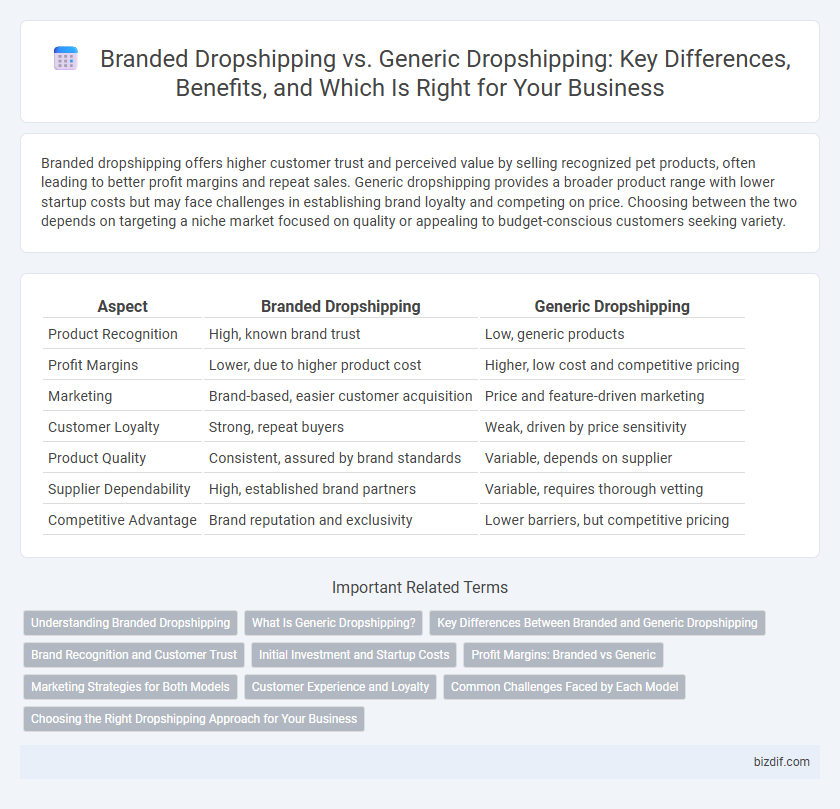Branded dropshipping offers higher customer trust and perceived value by selling recognized pet products, often leading to better profit margins and repeat sales. Generic dropshipping provides a broader product range with lower startup costs but may face challenges in establishing brand loyalty and competing on price. Choosing between the two depends on targeting a niche market focused on quality or appealing to budget-conscious customers seeking variety.
Table of Comparison
| Aspect | Branded Dropshipping | Generic Dropshipping |
|---|---|---|
| Product Recognition | High, known brand trust | Low, generic products |
| Profit Margins | Lower, due to higher product cost | Higher, low cost and competitive pricing |
| Marketing | Brand-based, easier customer acquisition | Price and feature-driven marketing |
| Customer Loyalty | Strong, repeat buyers | Weak, driven by price sensitivity |
| Product Quality | Consistent, assured by brand standards | Variable, depends on supplier |
| Supplier Dependability | High, established brand partners | Variable, requires thorough vetting |
| Competitive Advantage | Brand reputation and exclusivity | Lower barriers, but competitive pricing |
Understanding Branded Dropshipping
Branded dropshipping involves selling products under a distinct brand name, which enhances customer trust and allows for premium pricing through brand recognition and perceived value. This model requires building brand identity, investing in marketing, and managing supplier relationships to ensure product quality aligns with brand standards. Understanding branded dropshipping means recognizing the balance between higher upfront efforts and long-term benefits in customer loyalty and market differentiation.
What Is Generic Dropshipping?
Generic dropshipping involves selling unbranded or non-exclusive products sourced from multiple suppliers without proprietary trademarks. This model allows sellers to offer a wide range of low-cost items with minimal upfront investment, making it accessible for newcomers. However, generic dropshipping often faces intense competition and lower profit margins compared to branded dropshipping.
Key Differences Between Branded and Generic Dropshipping
Branded dropshipping involves selling products from well-known manufacturers, enhancing customer trust and enabling premium pricing, while generic dropshipping offers unbranded or white-label products at lower costs with higher profit margins. Inventory management in branded dropshipping often requires adherence to brand guidelines and retailer agreements, contrasting with the flexibility and broader product selection seen in generic dropshipping. Marketing strategies also differ, as branded dropshipping leverages established brand reputation whereas generic dropshipping relies heavily on price competitiveness and unique selling propositions.
Brand Recognition and Customer Trust
Branded dropshipping significantly enhances brand recognition by offering products with established reputations, which builds immediate customer trust and loyalty. Generic dropshipping often struggles to create consistent brand identity, resulting in lower perceived value and customer retention. Leveraging branded products can lead to higher conversion rates due to the existing credibility and trust associated with well-known names.
Initial Investment and Startup Costs
Branded dropshipping typically requires a higher initial investment due to costs associated with brand licensing, marketing, and securing supplier agreements that ensure product quality and exclusivity. Generic dropshipping demands lower startup costs since it relies on unbranded products, allowing sellers to avoid expenses related to brand development and focus primarily on setting up e-commerce platforms and basic advertising. Choosing between branded and generic dropshipping depends on the available budget, with branded models favoring higher upfront investment for long-term brand equity and generic models providing a cost-effective entry point.
Profit Margins: Branded vs Generic
Branded dropshipping typically offers higher profit margins due to perceived product value and customer trust, allowing sellers to charge premium prices. Generic dropshipping, while often featuring lower margins, benefits from reduced competition and greater pricing flexibility. Understanding the balance between brand recognition and cost efficiency is crucial for maximizing profitability in dropshipping ventures.
Marketing Strategies for Both Models
Branded dropshipping marketing strategies emphasize building customer trust and loyalty through consistent brand messaging, high-quality content, and personalized customer experiences, leveraging social media influencers and targeted advertisements to enhance brand recognition. Generic dropshipping focuses on competitive pricing, broad product variety, and SEO-driven content to drive traffic, often relying on mass marketing techniques, flash sales, and quick turnaround times to capture high-volume sales. Both models benefit from data-driven marketing analytics to optimize ad spend and customer targeting based on purchasing behavior and market trends.
Customer Experience and Loyalty
Branded dropshipping enhances customer experience by offering consistent product quality, reliable branding, and personalized customer service, which fosters higher loyalty and repeat purchases. Generic dropshipping often lacks brand recognition, leading to inconsistent quality and reduced trust, negatively impacting customer retention. Investing in a strong brand identity in dropshipping drives long-term loyalty and differentiated market positioning.
Common Challenges Faced by Each Model
Branded dropshipping faces challenges such as maintaining consistent brand identity, higher costs for authentic products, and reliance on supplier brand reputation. Generic dropshipping struggles with product differentiation, frequent price wars, and lower customer loyalty due to lack of unique branding. Both models contend with supply chain disruptions, variable shipping times, and quality control issues affecting customer satisfaction.
Choosing the Right Dropshipping Approach for Your Business
Branded dropshipping offers higher profit margins and stronger customer loyalty by leveraging established brand recognition, while generic dropshipping emphasizes product variety and lower upfront costs, appealing to budget-conscious entrepreneurs. Analyzing market demand, target audience, and long-term business goals is essential in selecting the appropriate dropshipping model. Prioritizing niche specialization in branded dropshipping or high-volume sales in generic dropshipping can significantly impact scalability and overall success.
Branded dropshipping vs generic dropshipping Infographic

 bizdif.com
bizdif.com